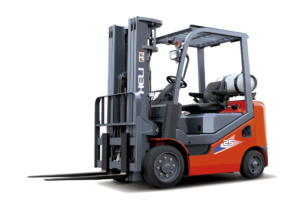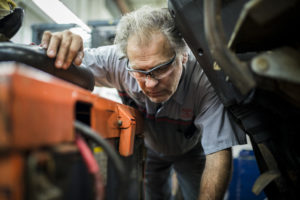Posts tagged ‘buying a used forklift’
Why You Should Choose a Heli Brand Forklift
Since 1991, HELI has been the #1 forklift manufacturer in China and the 7th largest manufacturer globally. With thousands of Heli forklifts in operation across the globe, let’s look at why Heli Forklifts is a top brand in the industry.
Heli Forklift’s Diverse Product Line 
One of the key factors contributing to Heli’s success is its diverse product line. Heli has designed and manufactured over 1,700 models, each tailored to serve a particular industry or role.
Heli offers electric, internal combustion, and diesel models to provide you with various choices to suit your needs. Whether you need a forklift to move building materials, transport heavy loads, or use in hot/cold weather, Heli has you covered.
Heli Forklifts Use A Variety of Engine Types
Understanding the engine is the heart of the forklift, Heli carefully chose engines from top manufacturers, including Kubota, GM, Mitsubishi, PSI, Deutz, and Cummins.
Heli Forklift’s Regenerative Braking
Heli is committed to providing its customers with the latest forklift technology. Select Heli forklift models come equipped with regenerative braking, a cutting-edge technology that can help reduce wear and tear on a forklift while also extending its operation time.
Heli Forklift’s Quick Delivery
While other dealers and brands have extended lead times for the 5,000 lb. capacity cushion tire trucks, we have HELI 5,000 lb. capacity IC cushion tire forklifts in stock for quick delivery.
See our full line of Heli products by clicking here.
Heli Forklift FAQs
Where are Heli’s warranty claims handled?
All U.S. Heli warranties coordinate through the Phoenix office, providing customers with a streamlined process for handling warranty-related issues.
How fast can we get Heli forklift parts?
Heli has a well-stocked parts facility in Phoenix, Arizona, to ensure quick and easy deliveries to keep your forklifts running smoothly.
Does Heli sell electric forklifts?
Yes! Heli has electric sit-down forklifts, stand-up forklifts, and walkie-pallet jacks, with load capacities from 2,000 lbs. to 22,000 lbs.
How many forklifts does Heli make a year?
As a global brand, Heli produces an impressive 160,000 forklifts per year from its factory in China.
Heli’s commitment to delivering first-class industrial equipment is evident in its track record. Customers rely on Heli forklifts to work shift after shift, week after week, without fail. In addition, Heli’s warranty work is handled in the U.S., ensuring you can get your equipment up and running again quickly and easily.
With a long history of providing dependable forklifts and a commitment to customer satisfaction, Heli is an excellent choice for a durable and reliable forklift.
How To Decide if LIB or LAB is Right for You
As environmental considerations and fluctuating oil prices continue to push consumers toward alternatives to traditional internal combustion engines, material handling operations increasingly look toward electric equipment solutions. Lead acid battery forklifts have been the standard for years, but with the new push towards zero- emission products, the Lithium-ion battery forklift may be the right fit for you.
In operations that utilize forklifts, far more electric units are now sold than those powered by internal combustion engines. Electric forklifts now make up nearly 70 percent of all trucks sold, and with increasing demand for electric power comes a need to provide a solution that provides all of the benefits of traditional engines without a loss in productivity.
Lead acid batteries have been a capable but imperfect solution for years, and they continue to dominate the market today. It is estimated that lead acid batteries power 90 percent of electric forklifts in operation.
WHAT IS A LIB?
A new player has emerged on the scene in recent years and is revolutionizing the way some companies do business. Lithium-ion battery (LiB) technology represents the next generation of forklift technology, and LiB’s market share in electric forklifts is expected to grow significantly in the coming years.
But while LiB technology offers unique benefits, these batteries don’t make sense for every operation. You can use a new metric – Equivalent Battery Usage (EBU) – to help you decide if making the shift to LiB batteries is best for you.
EBU measures the number of cycles customers typically use their lead acid batteries per day. A common threshold for determining whether LiB makes sense for your operation is 1.6 times per day. If your operation’s EBU is above 1.6, LiB could be a potential fit for you. If it falls below 1.6, however, it probably makes more sense to continue using lead acid.
Typically, multi-shift applications are above the 1.6 EBU threshold – so any customer operating their equipment for more than one shift per day is a good candidate for considering LiB technology.
The reason LiB doesn’t make sense for every customer today is simple – the high upfront cost and the high variability in return on investment. LiBs are more expensive than lead acid batteries, and they’re best used in high-throughput applications – such as distribution facilities, retail, and paper industries.
Are you considering the move the lithium-ion batteries? Schedule an appointment with an operations consultant today to learn which battery solution would best suit your unique needs.
Author: Justin Albers, Corporate Communications Specialist, Toyota Material Handling
The original content is located here.
Subscribe to Toyota Forklift’s blog here.
Do you want more info on forklift batteries? Read FAQs here.
How to Know When to Retire a Forklift
Your forklifts put in work day-in and day-out moving product and lifting and moving your business forward. The day will come when you lose time and money because the truck isn’t running as efficiently anymore. It may be difficult to pinpoint this time, but below are a few indicators that you may need a replacement forklift.
1. WEAR AND TEAR OF A FORKLIFT
Has forklift maintenance become a case of continual troubleshooting and increasing costs to keep your forklift running? If prolonged heavy use of your forklift fleet needs regular repairs, it may be time to consider replacing the equipment. When paying for continual repairs, the effect on the bottom line goes far beyond the cost of replacing worn bushings or repairing the electrical components in a drive motor. You may need a replacement forklift if you have some of the following repair needs:
- Hydraulic leaks
- Clogged fluid lines
- Worn chains
- A mast that won’t lift
- Battery problems
- Unbalanced suspension
- Steering difficulties
2. LOSING TIME, LOSING MONEY
When you experience downtime for any unit in your forklift fleet, the cost is much more than parts and labor. You also need to factor in lost productivity and the costs of idle time for operators when their equipment is being repaired. When lost profits due to delays in product movement are taken into account, the total financial impact of an older forklift can easily extend into the thousands of dollars… per hour! Keeping spare lifts on hand is not an optimal solution due to the overall increase in operating costs. Neither are quick replacements. While lower in initial costs, they can create an endless cycle of unplanned repairs that negatively impacts your business. Retiring a forklift may be necessary if this is affecting your material handling operation.
3. AVOIDING UNEXPECTED EVENTS
Poorly maintained equipment can lead to an accident or injury, which may be avoided through regular inspections and up-to-date regular maintenance. If your forklift is starting to show signs of wear and tear, it may be time to retire or replace your forklift.
If you are experiencing some or all of these scenarios with your equipment, it may be time to reach out to your authorized Toyota Forklift dealer for a conversation. They will be able to help determine if you are in need of new equipment and get you with the right forklift. If you want more information on forklift’s useful life, download our forklift management guide, “Is it Time to Upgrade Your Forklift?”
What You Need to Know About Used Forklifts
Are you in the market for used forklifts? Before you begin your search, ask yourself these questions first:
- How many hours do you currently use a forklift every day?
- Will the number increase in the next 12 months or during seasonal times throughout the year? If so, by how much?
Why are these questions important?
Used forklifts are great if you use them for less than four hours daily in a single-shift operation. However, if you need a forklift for more than a few hours a day, you may want to consider a new forklift purchase.
Okay, if you’ve done the math and determined a used forklift is the right material-handling equipment for you, here are the essential questions to ask before buying.
How has the forklift been used?
The answer is more important than you might think. Try to find out every possible application. For example, suppose you find out it was in a cold storage facility. In that case, you want to ensure it has an anti-corrosion protection system, which provides maximum resistance to harsh environmental factors. If not, you could have problems with rust in the future.
Has the forklift ever been a rental?
This is an important question to ask if you’re buying a used forklift from a dealership. Find out if it was a short-term or long-term rental and ask about its history. Try to find out if it was in any extreme environments or applications.
What’s the forklift’s service history?
 Find out the service intervals and what repairs were needed each time. Check if it was maintained by experienced technicians and repaired using certified parts.
Find out the service intervals and what repairs were needed each time. Check if it was maintained by experienced technicians and repaired using certified parts.
Carefully review the maintenance log, as it often reveals weaknesses. Look closely and ask questions if something doesn’t seem right. Has the mast or engine been serviced more than usual, or does something else look unusual?
Finding out a forklift’s history before buying a used forklift is a critical step to avoid costly downtime and expensive repairs. If you can’t get the information you need to make an informed decision, walk away.
Do you need help finding a suitable used forklift? We carry an extensive inventory of used, reconditioned forklifts for various applications. Contact us and let our experts find the perfect used forklift for you.
Forklift Tires: What You Need To Know
Just like an automobile, forklift tires significantly impact safety and performance. Knowing your options, what you need for your specific situation, and when to replace your tires is critical. Here’s a breakdown of what you need to know.
Know your application.
Weight. What is the average and maximum weight you carry on your forklift?
Terrain. Where do you drive the forklift? If indoors, are you on wet or slippery floors? If outdoors, is the terrain rocky or uneven?
Space. How much space do you have between the aisles and exit/entry points? Are you working in a small area with a tight turning radius?
Know your options.
There are two common forklift tires: cushion tires and pneumatic tires.
Cushion tires are solid rubber tires best for indoor applications. Cushion tires are perfect for lighter loads, light use, and small spaces. If you have a narrow aisle forklift or an order picker, cushion tires are probably the right tires for you.
Pneumatic tires are more durable and stable and offer better traction than cushion tires. Pneumatic tires are best for indoor-outdoor applications, unpaved surfaces, and uneven terrain. If you operate in a lumberyard or on gravel, pneumatic tires are most likely the right choice.
There are also several uncommon forklift tires. Polyurethane tires and foam fill tires are two options usually recommended for particular material handling applications only.
Know when to replace.
Here’s what to look for to decide if you need to replace your forklift tires.
Cuts or cracks. If you see cuts or cracks, it is a sure sign you need to replace your forklift tires.
Wear. Inspect forklift tires often for tire tread and balding. If you have pneumatic tires, use the two-inch rule. Check the height of the forklift tires. If the tires have worn down two inches or more from when they were new, it’s time to replace them.
If you have cushion tires, balding in any tire area is a sure sign to replace.
Know who to call.
We are experts at forklift tire applications, options, and use. Do you need help determining which forklift tire you need or if it’s time to replace it?
